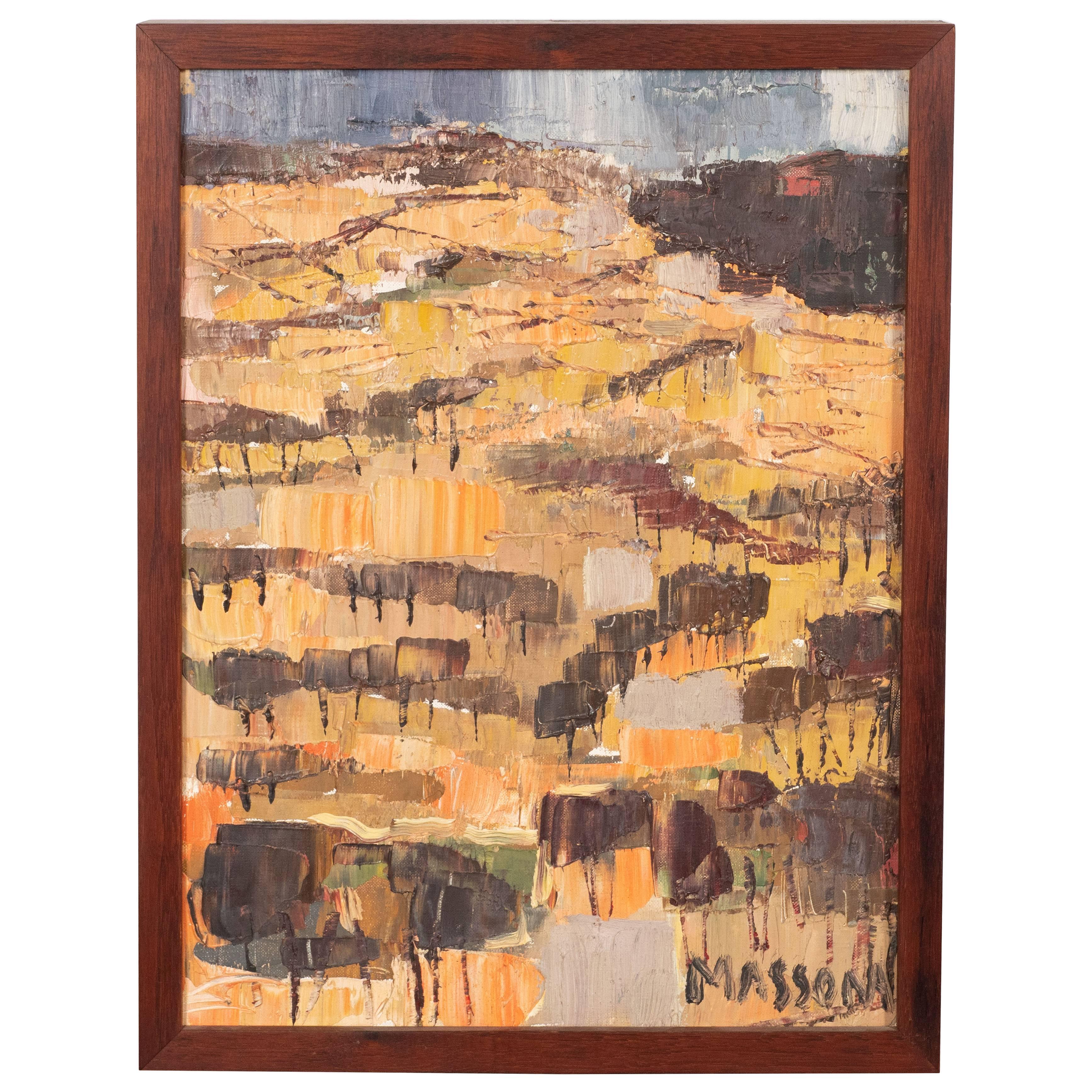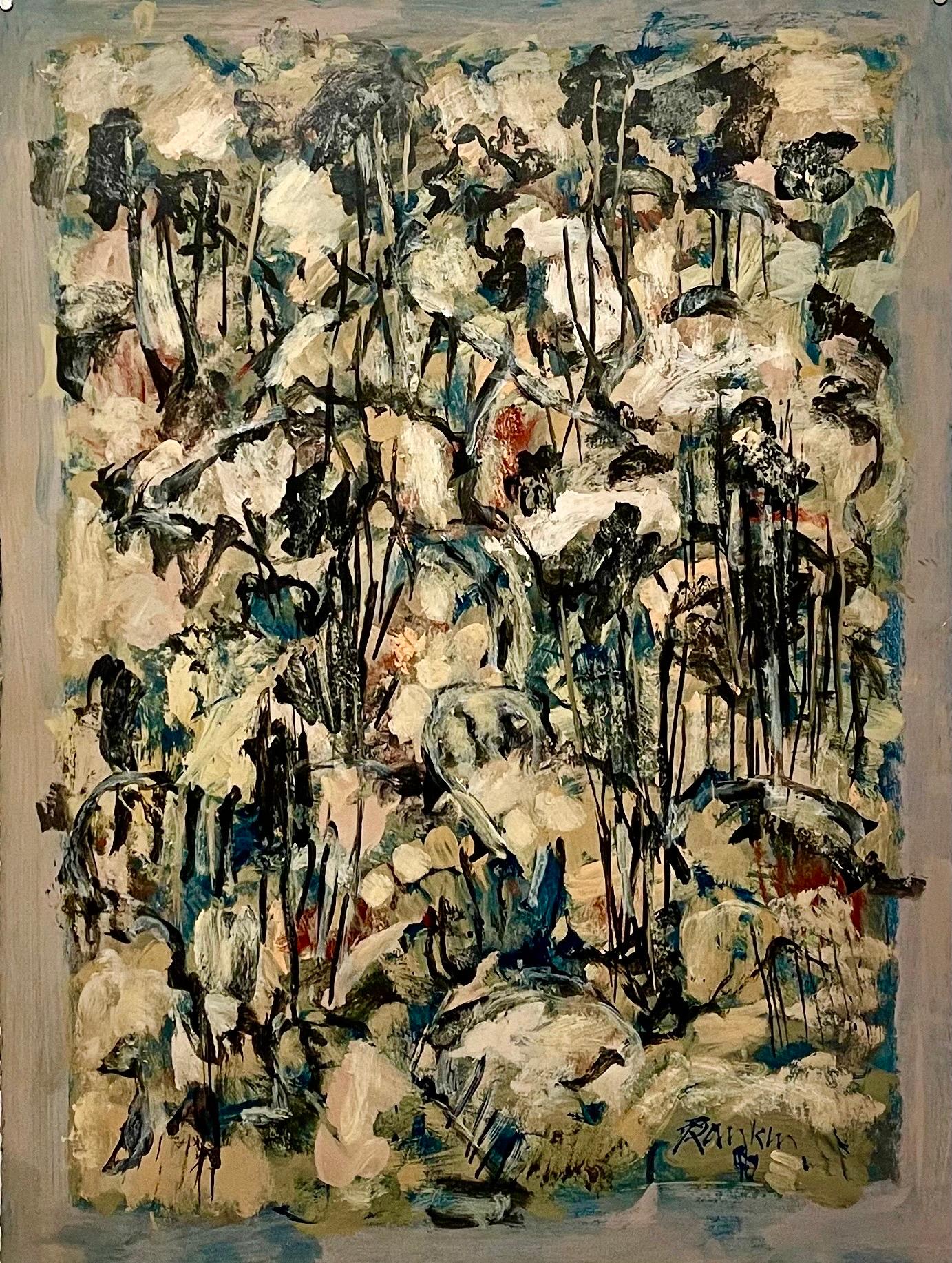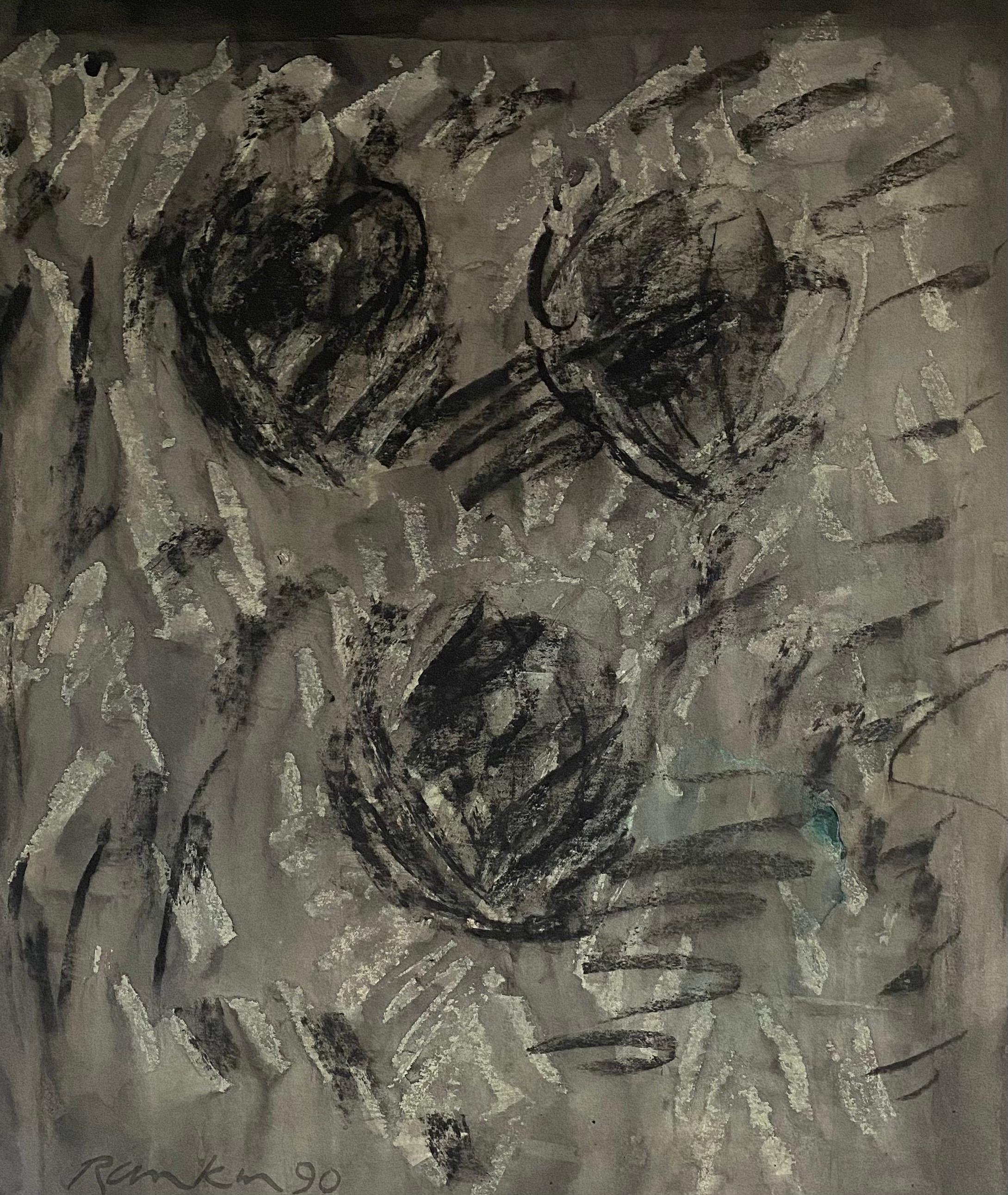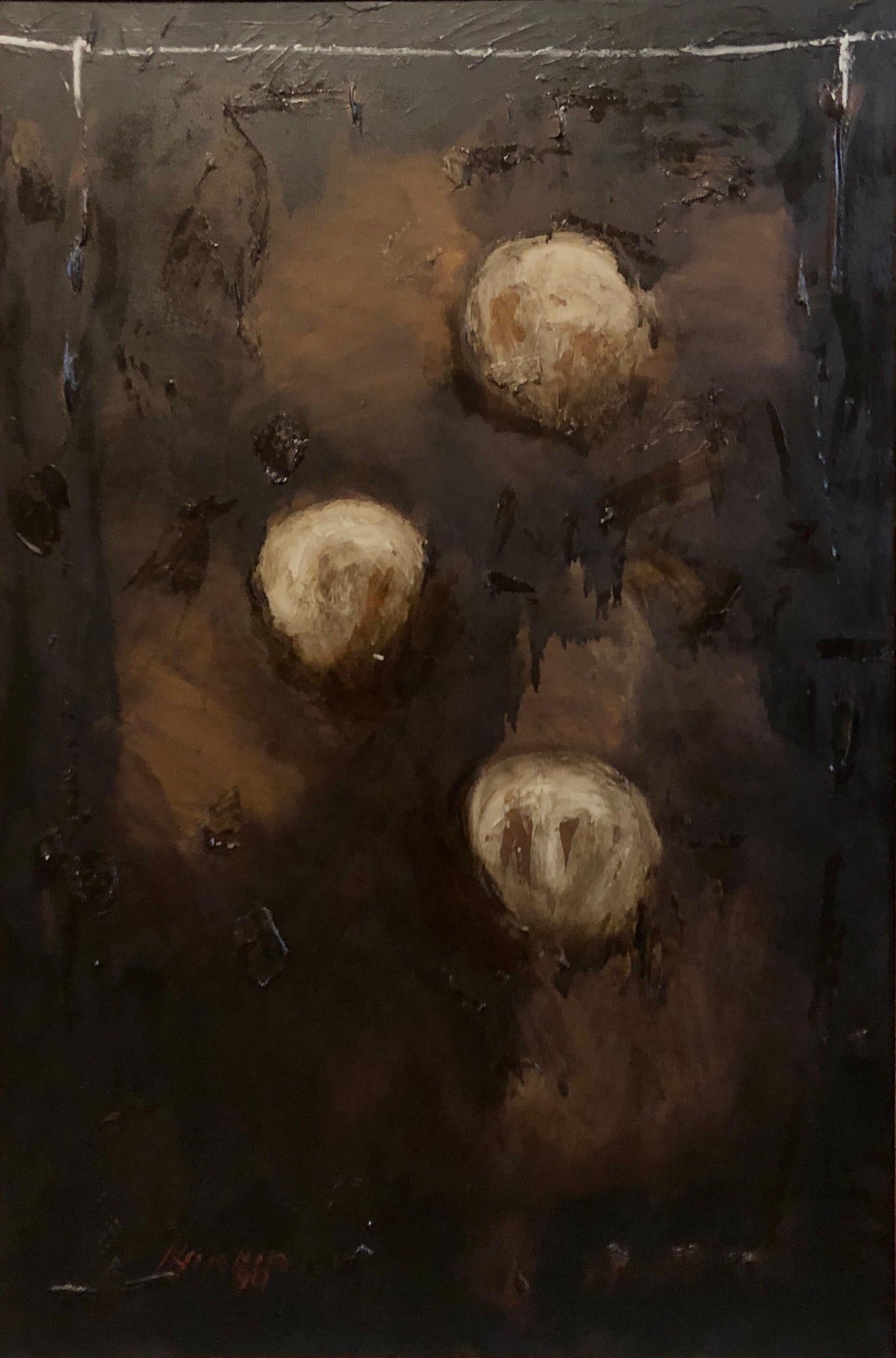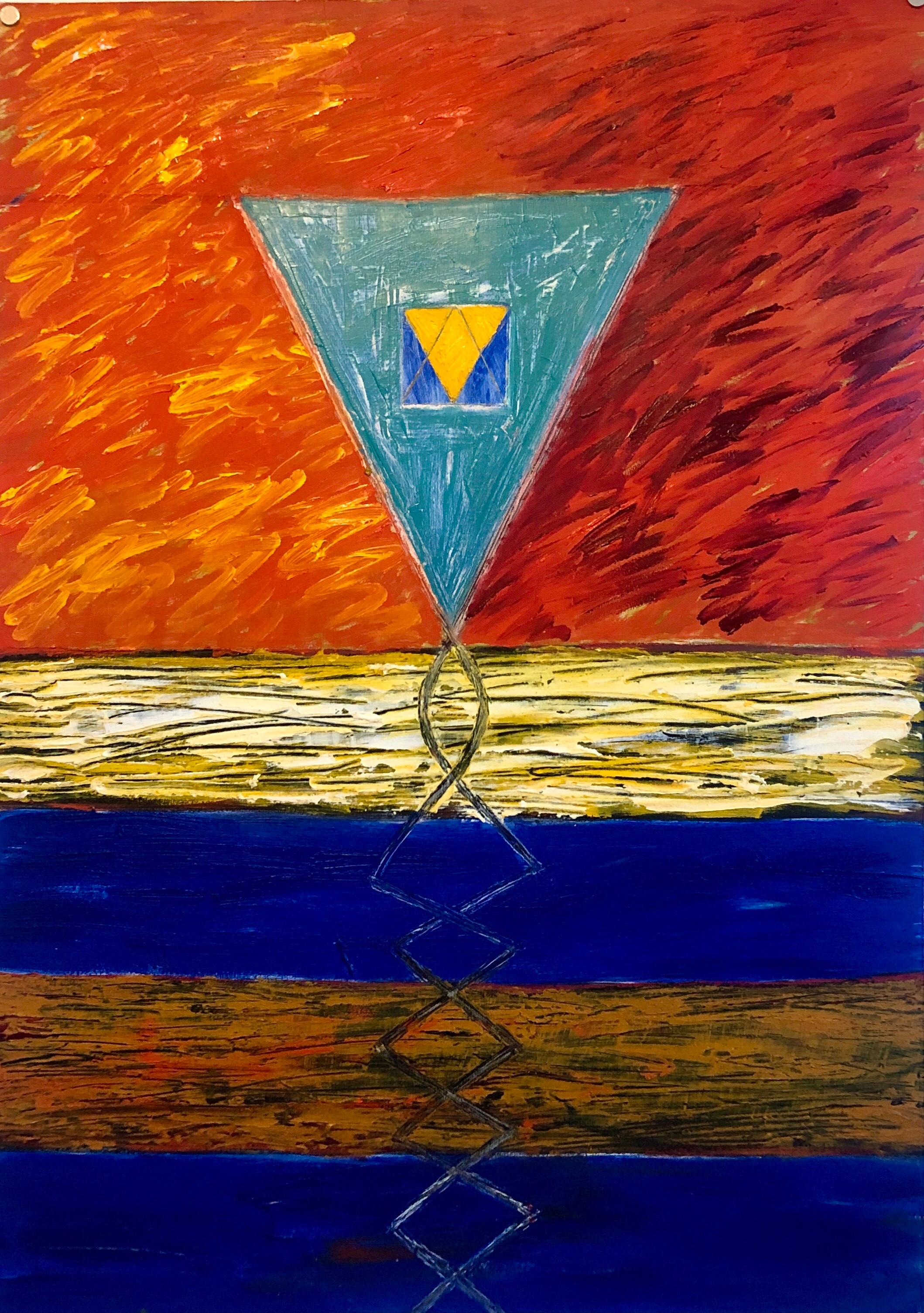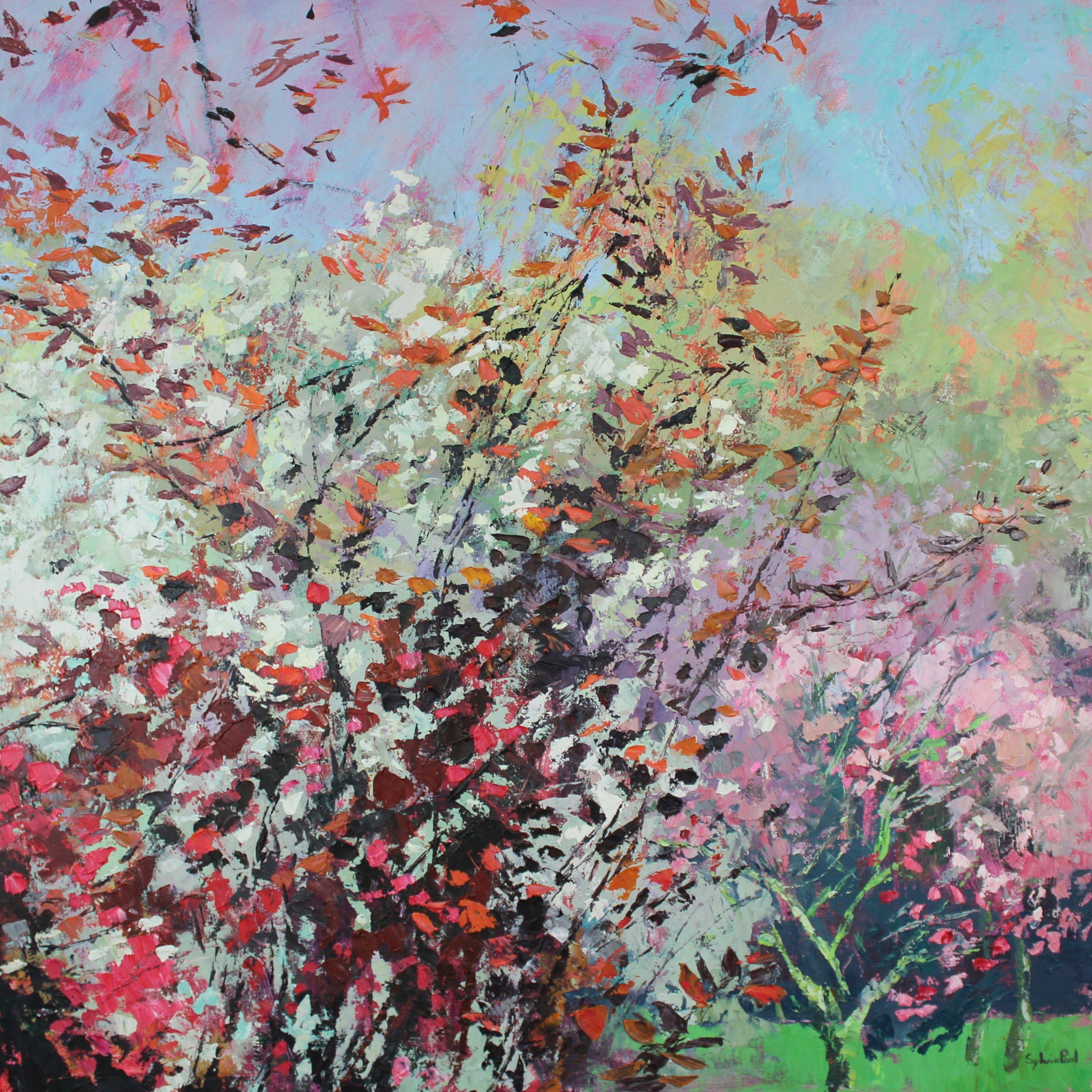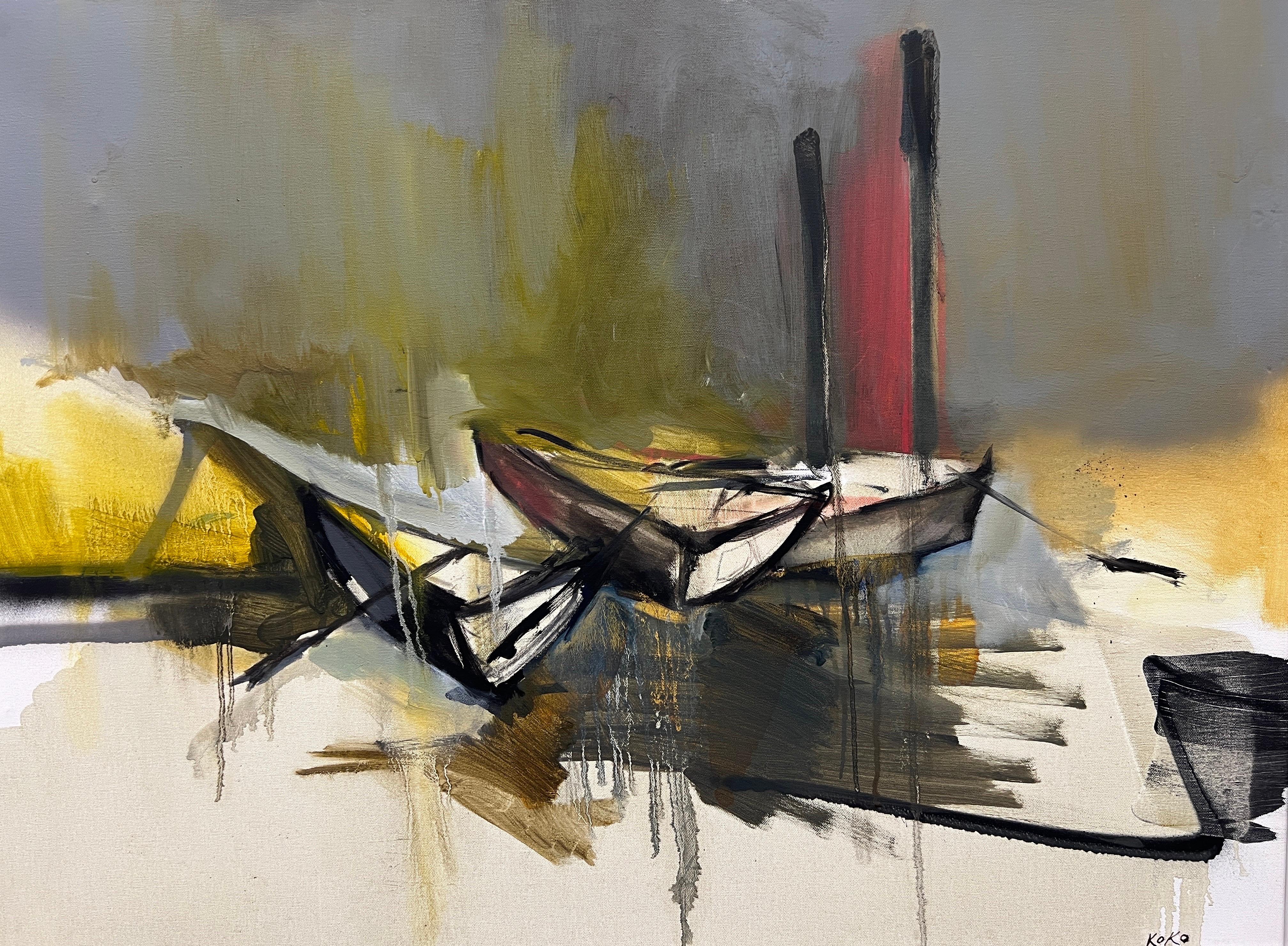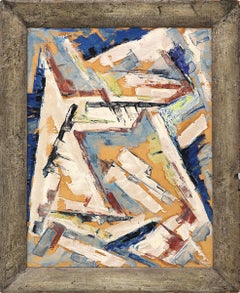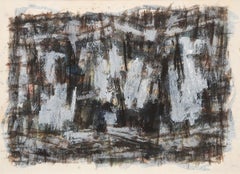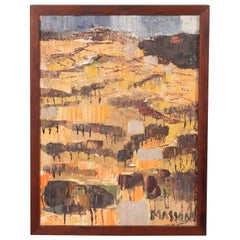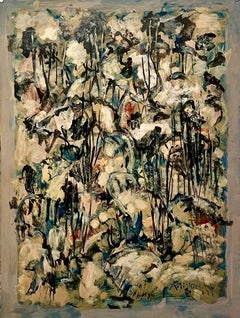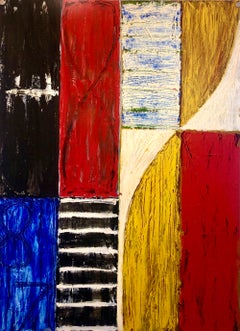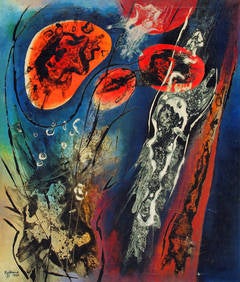
Painting #3
View Similar Items
Vance KirklandPainting #31960
1960
About the Item
- Creator:Vance Kirkland (30 x 28, American)
- Creation Year:1960
- Dimensions:Height: 41 in (104.14 cm)Width: 36 in (91.44 cm)
- Medium:
- Movement & Style:
- Period:
- Condition:
- Gallery Location:Denver, CO
- Reference Number:Seller: 198451stDibs: LU273363752
Vance Kirkland
As an artist and educator, Vance Kirkland almost single-handedly brought modern art to Denver. At a time when conservative tastes ruled, he came to Colorado and worked in a manner that emphasized process more than subject matter. Rather than pleasing landscapes, he created paintings that expressed the dynamic forces of the universe, often with results that were strange and otherworldly. Standing on principle, he never wavered from his conviction that the arts were respected disciplines and he constantly pushed for the inclusion of modern art in Denver’s public institutions. Deliberately working away from the major art centers, Kirkland’s varied art styles were determined by his compass yet were nationally recognized. Growing up in Ohio, Kirkland began his art studies at the Cleveland School of Art, where he received a diploma in painting and a bachelor’s degree in art education. The former curator of the Denver Art Museum, Diane Vanderlip points to a failed watercolor class as an indicator of both his future stylistic development and his early self-confidence. When the teacher criticized Kirkland for colors that fought with each other, the young man listened to his muse rather than pass the course. Upon graduation, he was offered a job at Princeton, but when the university discovered just how young he was, they withdrew their offer. He then accepted an offer at the University of Denver to establish their art department in 1929. While most schools shunted art offer to the side, Kirkland developed the program as a combination of academics and art. He also got officials to accept nude figure drawing. However, a parting of the ways came when he and the Provost clashed over degree recognition. The subsequent establishment of his Kirkland School of Art became a cultural beacon in this Rocky Mountain capitol. From 1927–44, he worked in a style he referred to as “Designed Realism,” in which natural forms were highly stylized in rhythmic shapes. Working totally in watercolor, he developed an individualized method of applying dots to a saturated color surface. By the end of the 30s, Kirkland’s paintings became larger and more energetic. Hiking in the mountains, the artist was inspired by the unusual shapes of high-altitude plants and trees stunted and bent by the fierce winds. Taking his painting gear, he had to add antifreeze to his paints to work in these demanding conditions. Departing from his ordinary perspective, Kirkland created compositions of open spaces and wild linear elements, which he increasingly liberated from any specific representation. In his fantastic imaginings, he had an affinity with Surrealism, although he had no interest in their Freudian pursuits. Kirkland received national attention with inclusion in exhibitions, such as “Abstract and Surrealist American Art” at the Art Institute of Chicago and “Reality and Fantasy” at the Walker Art Center. In 1946, Knoedler and Company in New York invited him to be one of their artists, which brought solo shows and group exhibitions with artists like Max Ernst. Beginning in the 1940s, he also became more active with the Denver Art Museum, serving in various honorary and formal positions. Both in his capacity as board member and curator, he relentlessly pressed for the recognition of contemporary art and artists. At the same time, his prestige grew when the University of Denver invited him back: this time as Director of the School of Art, Professor of Painting, and Chairman of the Department of Arts and Humanities. In 1941, he married Anne Fox Oliphant Olson, a librarian, and their home was a center for Denver’s cultural life with evening salons and musical performances. His first non-objective painting, Red Abstraction (1951) initiated his break with his past art. Looking back, Kirkland said, “There had to be a way of creating something and I became interested in abstraction.” Deciding to forego watercolor, he experimented with paint and materials, particularly with inventive ways of mixing them. He had always been intrigued by the quality of resistance, and now he used the combination of oil and water to cause unexpected effects. The surface of his canvases became almost like breathing skins. Committed to his new direction, Kirkland didn’t flinch when Knoedler’s dropped him for abandoning his commercially successful style. Moving to greater heights, Kirkland began painting large canvases that suggested cosmic phenomena, some of which he called “nebula.” Although the 50s saw the birth of space exploration, the artist deliberately avoided any astronomical study, preferring instead to paint the mystery beyond his knowledge. When he saw pre-Hubble photographs that looked startlingly similar, he decided to stop. Towards the end of his career, he returned to his earlier practice of layering the surface with dots. The works that first appeared in 1963 were geometric abstractions that share some of the qualities of contemporary Op Art. These later paintings were painstakingly done. Always a tireless worker, he pursued his art even after hepatitis made painting more difficult and physically excruciating, devising a system that suspended him over his canvases.
- Composition in Red and Blue - Abstract Expressionist 1950s Oil PaintingBy Charles Ragland BunnellLocated in Denver, CO'Composition in Red and Blue' is a vintage abstract expressionist original oil painting on board by Charles Bunnell (1897-1968) from 1951. Signed and dated by the artist in the lower left corner. Abstract composition painted in shades of white, cream, blue, red, and tan. Presented in a vintage frame, outer dimensions measure 28 ½ x 22 ½ x 1 inches. Image size is 24 x 18 inches. About the Artist: Charles Bunnell developed a love for art at a very young age. As a child in Kansas City, Missouri, he spent much of his time drawing. When he was unable to find paper he drew on walls and in the margins of textbooks for which he was often fined. Around 1915, Bunnell moved with his family to Colorado Springs, Colorado. He served in World War I and later used his GI Training to study at the Broadmoor Art Academy (later renamed the Colorado Springs Fine Arts Center) during 1922 and 1923. In 1922, he married fellow student, Laura Palmer. He studied with Ernest Lawson in 1927-1928 and, in the winter of 1928-1929, he served as Lawson’s assistant. In the late 1920’s, the Bunnell’s settled just west of Colorado Springs and 1928, they welcomed the first of their three children. Their one-acre homesite, which they referred to as “Old Home Place”, was situated between two sets of railroad tracks at the foot of Pike’s Peak. Charlie converted an old railroad boxcar into his studio, where he later gave lessons. Beginning in 1931, Bunnell spent a year and a half studying under Boardman Robinson. The two men clashed constantly due to a generation gap and markedly different philosophies. Robinson encouraged his students not to stray from realism and though Bunnell mastered Robinson’s preferred style of American Scene painting, he regularly irritated his professor with his abstract sketches. Bunnell taught at the Kansas City Art Institute during the summers of 1929, 1930, 1940, and 1941. Between 1934 and 1941, he painted and taught under federal projects which included assisting Frank Mechau on murals for the Colorado Springs Post Office. However, he did not take to mural making and, after criticism from Boardman Robinson about his use of “heavy daubs which have no place in mural work,” he abandoned mural-making altogether. By the late 1930’s, Bunnell’s work departed from the American Scene/Modernist style he was trained in towards abstraction. This is marked by his “Black and Blue” series, consisting of 83 abstracted ink and watercolors. Affected by the Second World War and the loss of his 10-year old son, Bunnell’s work of the early 1940’s took on a Transcendental and Surrealist tone. The works from this period are moody and readily reflect the political and personal turmoil experienced by the artist. In the late 1940’s, Bunnell began experimenting with Abstract Expressionism. He alone is credited with introducing Colorado Springs to the new style as it was excluded from the Fine Art Center’s curriculum by Boardman Robinson. Bunnell excelled in Abstract Expressionism and continued to evolve in the style through the 1950’s continuing to his death in 1968. He was recently recognized as a premier American Abstract Expressionist by his inclusion in the book American Abstract Expressionism of the 1950’s: An Illustrated Survey. Solo Exhibits: Kansas City Art Institute, Kansas City, Missouri, 1930; Santa Fe Museum, Santa Fe, New Mexico, 1947; University of Illinois, Urbana, Illinois, 1948; University of Kentucky, Lexington, Kentucky, 1949; Taos Gallery, Taos, New Mexico, 1951; Carl Barnett Galleries, Dallas, Texas, 1952; The Bodley Gallery, New York, 1955; Amarillo, Texas, 1955; Haigh Gallery, Denver, Colorado, 1955; Colorado Springs Fine Arts Center, Colorado Springs, Colorado, 1956; Dord Fitz Art Gallery, Amarillo, Texas, December 1956 – February 1957, 1959, 1969 (retrospective). Group Exhibits: Carnegie Institute, 1927-1928; Colorado State Fair, 1928 (1st prize); Artists Midwestern, Kansas City, Missouri, 1929 (Gold Medal); Art Institute of Chicago, 1947 (the exhibit traveled to ten major museums in the United States); “Artists West of the Mississippi”, Colorado Springs Fine Arts Center, Colorado Springs, Colorado (7 times); Denver Art Museum Western Annual, Denver, Colorado (5 times); Mid-America Annual, Kansas City, Missouri, 1958; First Provincetown Festival, 1958; Southwestern Annual, Santa Fe, New Mexico, Winter 1957-1958; Central City, Colorado; Cañon City...Category
1950s Abstract Expressionist Abstract Paintings
MaterialsCanvas, Oil
- 1950s Abstract Expressionist Oil Painting, Blue Brown Orange Sage GreenBy Charles Ragland BunnellLocated in Denver, COAbstract expressionist oil painting on board from 1955 by Charles Bunnell. Abstract shapes in layers of sage green, light blue, brown, gold, and black. Presented in a custom frame, o...Category
1950s Abstract Expressionist Abstract Paintings
MaterialsBoard, Oil
- 1950s Abstract Oil Painting, Framed Mid Century Modern Painting Blue Black WhiteBy Paul Kauver SmithLocated in Denver, COOriginal oil painting by mid-century modernist Paul K. Smith (1893-1977). Painted in a soft gray, blue, ivory, brown and black with subtle under layers of oran...Category
Mid-20th Century Abstract Expressionist Abstract Paintings
MaterialsOil
- Crystal, Series #3 Ros, 1960 Abstract Collage Painting in Purple & Pink TonesBy Margo HoffLocated in Denver, COMid-century modern abstract painting of crystal formations by Margo Hoff (1910-2008) created with acrylic and canvas collage in purple and pink coloring. Wrapped canvas is ready to hang, outer dimensions measure 49 x 49 x 1 ¼ inches. Provenance: Estate of the Artist, Margo Hoff About the Artist: Born Oklahoma 1910 Died New York 2008 A prolific artist, Margo Hoff’s exquisite style evolved throughout her career yet was always rooted in the events, people, and places in her life. The human experience was her sole focus, expressed through her eyes alone. Born in 1910 in Tulsa, Oklahoma, Hoff began creating white-clay animals at a young age, giving them to her friends and family. At eleven she contracted typhoid fever and was bedridden for a summer. During her convalescence, she drew and made cutouts, and it was during this time that her bold, artistic imagination came alive. She began formal art training in high school and continued her education at the University of Oklahoma, Tulsa. In 1933 she moved to Chicago and attended the National Academy of Art and the School of the Art Institute of Chicago. Between 1933 and 1960—her Chicago years—Hoff’s works was deeply rooted in a figurative, regionalist style. She often used elements of magical realism, and many of her paintings have dreamlike qualities. As a child she learned about color by grinding down rocks, plants, and berries. Her color pallet during the Chicago years is indicative of her early-life color experimentation as she consistently used warm, earth tones in her work. Hoff was a born adventurer and traveled extensively. She lived, worked, taught, and painted in Europe, Mexico, Lebanon, Uganda, Brazil, and China. She also showed at the Denver Art Museum’s Annual Western Exhibitions in 1952-54, 56, and 57. In 1957 she showed along side Colorado modernist Vance Kirkland at the Denver Art Museum’s exhibition, Man's Conquest of Space. What was once a focus on the representational, her work began to change after 1957 when she saw Sputnik in its orbit around Earth. At that moment, feet firmly placed on the ground, she was able to imagine herself in space, looking down from the cosmos, and what she saw was an abstracted world. She then had the opportunity to peer into an electron microscope where once again she was looking down into what seemed to be a realm of pure abstraction. These two events profoundly changed her perspective and she began to move from figural painting to abstract, geometric collage. In 1960, Hoff moved to New York City and she began creating collages. Placing the canvas on the ground, and working from all sides, she used strips of painted paper and tissue—and later painted pieces of canvas—glued onto the canvas surface, building layer upon layer, shape against shape, “action of color next to stillness of color.” She believed these simplified, abstracted forms held the spirit of the subject in the same way poetry reduces words to their essence. These pieces range from aerial cityscapes, to dancers in motions, to flora...Category
1960s Abstract Expressionist Paintings
MaterialsAcrylic, Mixed Media, Canvas, Oil
- Mid Century Modern Abstract Oil Painting by Werner Drewes, Green Blue Red YellowBy Werner DrewesLocated in Denver, COAbstract oil on canvas painting by Werner Drewes painted in vibrant shades of green, blue, and red from 1944. Signed by the artist in the lower right corner of the canvas. Presented ...Category
20th Century Abstract Expressionist Abstract Paintings
MaterialsOil
$6,975 Sale Price20% Off - 1950s Framed Abstract Expressionist Oil Painting, Mid Century Modern, Green RedBy Charles Ragland BunnellLocated in Denver, COVintage 1950s mid century modern abstract expressionist painting by Colorado artist, Charles Ragland Bunnell in shades of red, green, white, and black. Presented in the artist's orig...Category
1950s Abstract Expressionist Abstract Paintings
MaterialsOil, Wood
- Abstract HilltopLocated in New York, NYThis stunning and sophisticated oil on canvas painting, entitled "Abstract Hilltop" was realized in the United States, circa 1960. It features an array of color blocks in tones of ch...Category
1960s Abstract Expressionist Abstract Paintings
MaterialsOil
- Australian American D. Rankin Abstract Expressionist Oil Painting Rocky HillsideBy David RankinLocated in Surfside, FLDavid Rankin, American (b. 1946) Rocky Hillside, (1990) Oil on paper Hand signed lower right, signed and titled verso. 30 x 22 1/2 inches David Rankin is a New York-based, British-born Australian post-war and contemporary artist known for his expressionistic abstract paintings. His work can be categorized by his use of quick, loose brushstrokes, reminiscent of scribbles on a page. Rankin works predominantly in oil painting and acrylic on canvas, but also works with paper, prints, sculptures and ceramics. Rankin has held over 100 one-person exhibitions in cities across the world, including New York, London, Paris, Beijing, Mexico, Vienna, Berlin and Cologne, as well as all over Australia. Represented in many of the world’s leading public and private collections and museums, David Rankin’s work is featured in Australia’s leading institutions, including the National Gallery of Australia, Art Gallery of New South Wales, National Gallery of Victoria and Queensland Art Gallery. David Rankin was born in Plymouth, Devon, England in 1946 then emigrated to Australia with his family in 1948. He spent his childhood in the 1950s in the semi-rural Port Hacking region South of Sydney and his teenage years in country New South Wales, from Hay, Wagga Wagga and Albury in the South to Bourke and Brewarrina in the North. Rankin is self-taught, developing his techniques and ideas in the outback towns of his youth. He was inspired by the greats from Leonardo da Vinci to Paul Klee as well as being influenced by the history of Buddhism and Asian art. In his travels before he arrived in Sydney in 1967 he developed a concept of what he wanted to achieve as an Australian artist. His dream was to express the anima, the life spirit or the essence of God in all nature. As an Australian artist he believed could bring the elements of Western Art together with an understanding and love for the cultures of Asia and the Australian Aborigine. He also felt that as Australia was closer to Asia than Europe it made sense to think about the art of Indian, Chinese and Japanese artists, and that one could not be an authentic articulate Australian artist without a love and respect for the artistic and spiritual expressions of the various Aboriginal artists, peoples and cultures. His work combined elements of Abstract Expressionist painting with Jewish and Aboriginal influences. In 1979 his first wife, Jennifer Mary Roberts (née Haynes) died. Rankin subsequently met his current wife Lily Brett, whose own life was etched by tragedy with her parents being survivors of the Holocaust. She too migrated to Australia as a child after the Second World War in 1948. The artist recounts that his empathy for Lily and the pity for his first wife's death fused into what he calls "the dark blessing of my life." The darkness was transformed into images. The author Dore Ashton writes that the events of 1979 and the fire which ravished his studio in 1997 and burnt his art works and many personal possessions, had a profound impact on his work. Having personal life experiences as his subject matter, Rankin's paintings contemplate these things. For example, his Jerusalem series followed a trip to Jerusalem in 1988, which then led to his Golgotha works. His travels to the Australian, American and Mexican deserts became the subject matter for many of his canvases, such as Ridge – Mungo, Golden Prophecy – San Antonio, Grey Sonora Landscape and then led to his Witness Series. From the fire in his studio he then painted Buddha and Flames. He illustrated two books by Lily Brett on the holocaust and explored the theme further in his huge work The Drowned and The Saved from a book by Primo Levi of the same name. Through Brett he encountered Jewish mythology and painted judaica imagery, Black...Category
1990s Abstract Expressionist Abstract Paintings
MaterialsPaper, Oil
- Joan Kahn Rome Vibrant Bold Color Abstract Expressionist Modernist Oil PaintingLocated in Surfside, FLOil paint on heavy tar paper. Hand signed and dated verso. Joan Kahn (USA 1953-) grew up in New York City; Princeton, New Jersey; and Vermont; in an envir...Category
1980s Abstract Expressionist Abstract Paintings
MaterialsOil
- Australian Abstract Expressionist Gouache Painting Charcoal on Shaped PaperBy David RankinLocated in Surfside, FLDavid Rankin American (b. 1946) Untitled (Black on gray) (1990) Gouache and charcoal on paper signed lower left 19 x 15 inches Rankin is a New York-based, British-born Australian post-war and contemporary artist known for his expressionistic abstract paintings. His work can be categorized by his use of quick, loose brushstrokes, reminiscent of scribbles on a page. Rankin works predominantly in oil painting and acrylic on canvas, but also works with paper, prints, sculptures and ceramics. Rankin has held over 100 one-person exhibitions in cities across the world, including New York, London, Paris, Beijing, Mexico, Vienna, Berlin and Cologne, as well as all over Australia. Represented in many of the world’s leading public and private collections and museums, David Rankin’s work is featured in Australia’s leading institutions, including the National Gallery of Australia, Art Gallery of New South Wales, National Gallery of Victoria and Queensland Art Gallery. David Rankin was born in Plymouth, Devon, England in 1946 then emigrated to Australia with his family in 1948. He spent his childhood in the 1950s in the semi-rural Port Hacking region South of Sydney and his teenage years in country New South Wales, from Hay, Wagga Wagga and Albury in the South to Bourke and Brewarrina in the North. Rankin is self-taught, developing his techniques and ideas in the outback towns of his youth. He was inspired by the greats from Leonardo da Vinci to Paul Klee as well as being influenced by the history of Buddhism and Asian art. In his travels before he arrived in Sydney in 1967 he developed a concept of what he wanted to achieve as an Australian artist. His dream was to express the anima, the life spirit or the essence of God in all nature. As an Australian artist he believed could bring the elements of Western Art together with an understanding and love for the cultures of Asia and the Australian Aborigine. He also felt that as Australia was closer to Asia than Europe it made sense to think about the art of Indian, Chinese and Japanese artists, and that one could not be an authentic articulate Australian artist without a love and respect for the artistic and spiritual expressions of the various Aboriginal artists, peoples and cultures. His work combined elements of Abstract Expressionist painting with Jewish and Aboriginal influences. In 1979 his first wife, Jennifer Mary Roberts (née Haynes) died. Rankin subsequently met his current wife Lily Brett, whose own life was etched by tragedy with her parents being survivors of the Holocaust. She too migrated to Australia as a child after the Second World War in 1948. The artist recounts that his empathy for Lily and the pity for his first wife's death fused into what he calls "the dark blessing of my life." The darkness was transformed into images. The author Dore Ashton writes that the events of 1979 and the fire which ravished his studio in 1997 and burnt his art works and many personal possessions, had a profound impact on his work. Having personal life experiences as his subject matter, Rankin's paintings contemplate these things. For example, his Jerusalem series followed a trip to Jerusalem in 1988, which then led to his Golgotha works. His travels to the Australian, American and Mexican deserts became the subject matter for many of his canvases, such as Ridge – Mungo, Golden Prophecy – San Antonio, Grey Sonora Landscape and then led to his Witness Series. From the fire in his studio he then painted Buddha and Flames. He illustrated two books by Lily Brett on the holocaust and explored the theme further in his huge work The Drowned and The Saved from a book by Primo Levi of the same name. Through Brett he encountered Jewish mythology and painted judaica imagery, Black Menorah...Category
1990s Abstract Expressionist Abstract Paintings
MaterialsCanvas, Oil
- Australian Abstract Expressionist Oil PaintingBy David RankinLocated in Surfside, FLDavid Rankin is a New York-based, British-born Australian post-war and contemporary artist known for his expressionistic abstract paintings. His work can be categorized by his use of quick, loose brushstrokes, reminiscent of scribbles on a page. Rankin works predominantly in oil painting and acrylic on canvas, but also works with paper, prints, sculptures and ceramics. Rankin has held over 100 one-person exhibitions in cities across the world, including New York, London, Paris, Beijing, Mexico, Vienna, Berlin and Cologne, as well as all over Australia. Represented in many of the world’s leading public and private collections and museums, David Rankin’s work is featured in Australia’s leading institutions, including the National Gallery of Australia, Art Gallery of New South Wales, National Gallery of Victoria and Queensland Art Gallery. David Rankin was born in Plymouth, Devon, England in 1946 then emigrated to Australia with his family in 1948. He spent his childhood in the 1950s in the semi-rural Port Hacking region South of Sydney and his teenage years in country New South Wales, from Hay, Wagga Wagga and Albury in the South to Bourke and Brewarrina in the North. Rankin is self-taught, developing his techniques and ideas in the outback towns of his youth. He was inspired by the greats from Leonardo da Vinci to Paul Klee as well as being influenced by the history of Buddhism and Asian art. In his travels before he arrived in Sydney in 1967 he developed a concept of what he wanted to achieve as an Australian artist. His dream was to express the anima, the life spirit or the essence of God in all nature. As an Australian artist he believed could bring the elements of Western Art together with an understanding and love for the cultures of Asia and the Australian Aborigine. He also felt that as Australia was closer to Asia than Europe it made sense to think about the art of Indian, Chinese and Japanese artists, and that one could not be an authentic articulate Australian artist without a love and respect for the artistic and spiritual expressions of the various Aboriginal artists, peoples and cultures. His work combined elements of Abstract Expressionist painting with Jewish and Aboriginal influences. In 1979 his first wife, Jennifer Mary Roberts (née Haynes) died. Rankin subsequently met his current wife Lily Brett, whose own life was etched by tragedy with her parents being survivors of the Holocaust. She too migrated to Australia as a child after the Second World War in 1948. The artist recounts that his empathy for Lily and the pity for his first wife's death fused into what he calls "the dark blessing of my life." The darkness was transformed into images. The author Dore Ashton writes that the events of 1979 and the fire which ravished his studio in 1997 and burnt his art works and many personal possessions, had a profound impact on his work. Having personal life experiences as his subject matter, Rankin's paintings contemplate these things. For example, his Jerusalem series followed a trip to Jerusalem in 1988, which then led to his Golgotha works. His travels to the Australian, American and Mexican deserts became the subject matter for many of his canvases, such as Ridge – Mungo, Golden Prophecy – San Antonio, Grey Sonora Landscape and then led to his Witness Series. From the fire in his studio he then painted Buddha and Flames. He illustrated two books by Lily Brett on the holocaust and explored the theme further in his huge work The Drowned and The Saved from a book by Primo Levi of the same name. Through Brett he encountered Jewish mythology and painted judaica imagery, Black Menorah...Category
1990s Abstract Expressionist Abstract Paintings
MaterialsCanvas, Oil
- Joan Kahn Rome Vibrant Bold Color Abstract Expressionist Modernist Oil PaintingLocated in Surfside, FLOil paint on heavy tar paper. Hand signed and dated verso. Joan Kahn (USA 1953-) grew up in New York City; Princeton, New Jersey; and Vermont; in an envir...Category
1980s Abstract Expressionist Abstract Paintings
MaterialsOil
